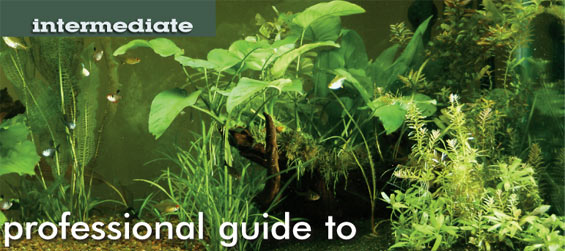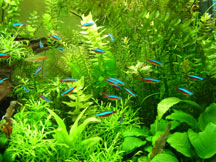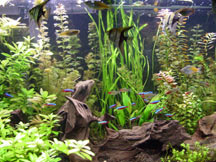by Special Guest Contributor
Greg Morin, Ph.D., President/CEO Seachem Laboratories, Inc.


Although often considered too difficult for the beginning hobbyist, planted aquariums are actually ideal for the beginner. The sheer number of factors required for plant growth and health may seem daunting at first; however, we can broadly classify these factors into three categories: substrates, pH/hardness, and supplements. Then, the task of deciding what is needed becomes more manageable. Each category builds upon the one before to ensure a flourishing environment at every stage.
Substrates
Start with a high quality, mineral rich gravel such as Seachem's
Flourite to lay the foundation for further success. Although a low cost gravel may save money in the short term, this will be more than offset by a necessitated increase in use of supplements to make up for the shortcomings of such gravels. With quality gravel, one could actually just add a few fish and have a successful planted aquarium. It is not likely to win any awards, but the overall simplicity of maintenance will appeal to even the beginning hobbyist. For those who desire faster growth and richer greens, here's how to take it to the next level.
| Glossary terms: |
|
pH |
- a measure of the acid content of the water. With a range of 1-14, the smaller pH numbers translate into higher acidity levels with a pH of 7 being neutral |
|
KH |
- a measure of the bicarbonate and carbonate content of the water. Because carbonates act as pH buffers, you will find that KH and pH generally rise and fall together |
|
GH |
- a measure of the calcium and magnesium content of the water. For both KH and GH, low values correspond to 'soft' and high values to 'hard' |
|
RO |
- short for Reverse Osmosis, a method of demineralization |
|
pH/Hardness (KH and GH)
This next level begins with pH/Hardness optimization with buffers and mineral salts. The native environment of some plants, like Cryptocoryne, is soft whereas others such as Sagittaria subulata are more acclimated to hard water.
For soft water plants: If the source water is hard, one will need to soften it either by using an RO system or by purchasing already dimineralized / deionized water. Once the water is softened, adjust pH and KH with
Acid Buffer and Alkaline Buffer, and then GH with Equilibrium as needed. Many soft water plants grow quite well in a hard water environment, thus if the source water is hard it may be worthwhile to try it first to see how plants fare. If they do well, then demineralization would not be necessary.
For hard water plants: The task is a bit easier since only minor adjustments to the presumably soft source water would be needed. If the source water is already hard, then pH may be the parameter needing adjustment.
Supplementation
Supplementation encompasses organic nutrients (vitamins, amino acids, carbon, etc.), as well as micro, and trace elements (such as iron, manganese, nickel, and cobalt). I recommend starting with
Flourish and/or
Flourish Tabs. These provide a broad range of micro-nutrients, along with micro and trace elements that will enhance plant health and growth. During substantial growth, trace elements are often utilized more rapidly than other components in Flourish. In this case, it would be beneficial to also employ
Flourish Trace along with Flourish and/or Flourish Tabs.
 Because plant nutrient requirements, usage rates, and source water can vary drastically, we have determined that the ideal approach to supplementation is to separate each component so that each can be dosed individually as needed. The five main parameters that need direct control can be provided with products such as:
Flourish Nitrogen,
Flourish Phosphorus,
Flourish Potassium,
Flourish Excel (Carbon), and
Flourish Iron. All are essential for plant processes, including growth and energy.
Because plant nutrient requirements, usage rates, and source water can vary drastically, we have determined that the ideal approach to supplementation is to separate each component so that each can be dosed individually as needed. The five main parameters that need direct control can be provided with products such as:
Flourish Nitrogen,
Flourish Phosphorus,
Flourish Potassium,
Flourish Excel (Carbon), and
Flourish Iron. All are essential for plant processes, including growth and energy.
Carbon supplementation
Because carbon availability is normally the limiting factor to growth, addition of carbon dioxide (CO2) to a planted aquarium will always result in large increases in growth (assuming other critical elements are not lacking). Without additional CO2 the growth rate will be dependent on the rate at which atmospheric CO2 equilibrates into the water. CO2 will dissolve into CO2–free water to a degree that is dependent on the air pressure, temperature, pH, and bicarbonate/carbonate content of the water. The final concentration of CO2 in the water depends entirely on those factors. Once that concentration is achieved, the level of CO2 will not change unless the plants remove it or one of the other factors is altered. Plants remove CO2 at a rate much greater than the rate at which it equilibrates into the water. So at the height of CO2 utilization the plants limit their own growth by using up all available CO2.
Because CO2 is an integral component of the bicarbonate buffer system, a drop in CO2 will necessarily result in a rise in pH. As the pH rises the influx of additional atmospheric CO2 will be diminished by its conversion to bicarbonate. This is offset somewhat by hard water plants that can utilize bicarbonate directly. However, without routine water changes or buffer additions (Alkaline Buffer or Liquid Alkaline Buffer) this path will eventually lead to complete depletion of the KH (carbonate hardness) which will result in dramatic pH swings from day to night (5.7 – 9.6). Using a
CO2 injection system will bypass this predicament by delivering a constant source of CO2. Because the introduction of CO2 will lower pH, one has two options:
A metering system is ideal because as the pH falls below a certain point the CO2 turns off, thus avoiding catastrophic pH drops.
 If one is not quite ready for the initial investment in a CO2 injection system but would still like to enjoy some of the benefits of adding additional carbon there is an alternative:
Flourish Excel. Flourish Excel is a supplement that provides a simple organic carbon molecule (similar to what is described above in the photosynthesis discussion) that plants can use as a building block for more complex carbohydrates. Because Flourish Excel is an organic carbon source it does not impact pH. Even if one is already using CO2 one can still obtain a cumulative benefit by using Flourish Excel in conjunction with CO2.
If one is not quite ready for the initial investment in a CO2 injection system but would still like to enjoy some of the benefits of adding additional carbon there is an alternative:
Flourish Excel. Flourish Excel is a supplement that provides a simple organic carbon molecule (similar to what is described above in the photosynthesis discussion) that plants can use as a building block for more complex carbohydrates. Because Flourish Excel is an organic carbon source it does not impact pH. Even if one is already using CO2 one can still obtain a cumulative benefit by using Flourish Excel in conjunction with CO2.
Conclusion
Although planted aquariums are often considered to be difficult for the beginning hobbyist, we believe that they are actually ideal for the beginner. With the right substrate, the beginner can have a successful aquarium with minimum maintenance. As the beginner becomes more comfortable in the hobby, they can build on the solid foundation they have already established.
Biography
 Greg Morin is the President and CEO of Seachem Laboratories, Inc. and has been with the company since its inception over 20 years ago. He graduated from Notre Dame with a Ph.D. in organic chemistry and is actively involved in developing new and innovative products.
Greg Morin is the President and CEO of Seachem Laboratories, Inc. and has been with the company since its inception over 20 years ago. He graduated from Notre Dame with a Ph.D. in organic chemistry and is actively involved in developing new and innovative products.
|